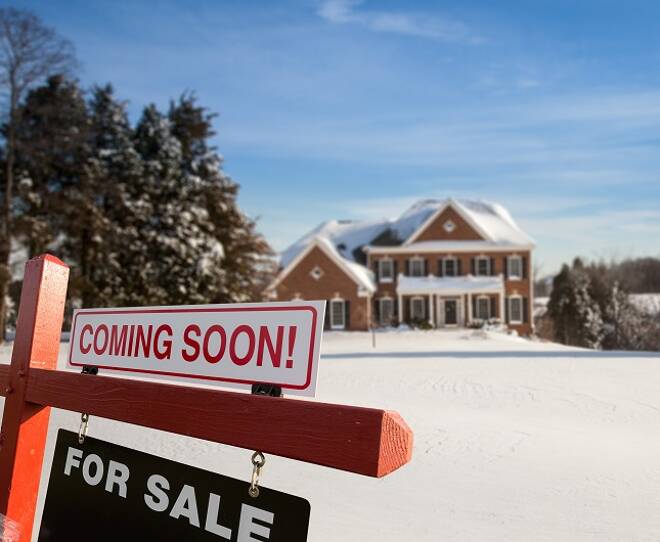Advertisement
Advertisement
U.S Mortgage Rates Rise Again. The Upward Trend Looks Set to Continue…
By:
Mortgage rates were on the rise once more, weighing on demand amidst labor and material shortages. Economic data in the week ahead may not be enough to ease upward pressure on rates...
Mortgage rates were on the rise once more, holding onto 3% levels for just the 4th time since 21st April.
In the week ending 21st October, 30-year fixed rates increased by 4 basis points to 3.09%.
Compared to this time last year, 30-year fixed rates were up by 29 basis points.
30-year fixed rates were still down by 185 basis points since November 2018’s last peak of 4.94%, however.
Economic Data from the Week
It was a quiet first half of the week on the U.S economic calendar.
While on the quieter side, the stats were skewed to the negative.
In September, industrial production fell by 1.3%, following a 0.1% decline in August.
Housing sector data also disappointed.
Building permits slid by 7.7% in September, with housing starts declining by 1.6%. In August, building permits had risen by 5.6% and housing starts by 1.2%.
From China, economic data also weighed on riskier assets, with the Chinese economy growing at a snails pace in the 3rd quarter.
The numbers were not weak enough, however, to send mortgage rates back to sub-3%, with the markets now looking towards a tapering next month and possibly more in the new year.
Freddie Mac Rates
The weekly average rates for new mortgages as of 21st October were quoted by Freddie Mac to be:
- 30-year fixed rates rose by 4 basis points to 3.09% in the week. This time last year, rates had stood at 2.80%. The average fee remained unchanged at 0.7 points.
- 15-year fixed increased by 3 basis points to 2.33% in the week. Rates were unchanged from a year ago. The average fee remained unchanged at 0.7 points.
- 5-year fixed rates slipped by 1 basis point to 2.54%. Rates were down by 33 points from 2.87% a year ago. The average fee rose from 0.2 points to 0.3 points.
According to Freddie Mac,
- Mortgage rates continued to rise this week due to the trajectory of both the economy and the pandemic.
- Even as the availability of existing homes is improving, prices remain high due to homebuyer demand and limitations on housing starts and permits.
- Ongoing labor and material shortages continue to limit new builds.
- Despite these countervailing forces, we expect the housing market to remain strong as we head into the end of the year.
Mortgage Bankers’ Association Rates
For the week ending 15th October, the rates were:
- Average interest rates for 30-year fixed with conforming loan balances increased from 3.18% to 3.23%. Points decreased from 0.37 to 0.35 (incl. origination fee) for 80% LTV loans.
- Average 30-year fixed mortgage rates backed by FHA fell from 3.20% to 3.17%. Points increased from 0.31 to 0.32 (incl. origination fee) for 80% LTV loans.
- Average 30-year rates for jumbo loan balances increased from 3.22% to 3.26%. Points increased from 0.29 to 0.33 (incl. origination fee) for 80% LTV loans.
Weekly figures released by the Mortgage Bankers Association showed that the Market Composite Index, which is a measure of mortgage loan application volume, slid by 6.3% in the week ending 15th October. In the previous week, the index had increased by 0.2%.
The Refinance Index tumbled by 7% and was 22% lower than the same week a year ago. In the week prior, the index had fallen by 1.0%.
The refinance share of mortgage activity fell from 63.9% to 63.3% of total applications in the week ending 15th October. In the previous week, the share had declined from 64.5% to 63.9% of total applications.
According to the MBA,
- Refinance applications fell for a 4th week as rates increased, bringing the refinance index to its lowest level since July-2021.
- 30-year fixed rates were up 20 basis points over the past month, reaching the highest level since April-2021.
- Purchase activity declined and was 12% lower than a year ago.
- Insufficient housing supply and elevated home-price growth continue to limit options for would-be buyers.
For the week ahead
It’s a busier first half of the week on the U.S economic calendar.
Consumer confidence figures for October will influence on Tuesday. Weaker confidence levels will test support for riskier assets.
On Wednesday, core durable goods and durable goods orders will also provide U.S Treasuries with direction.
With the markets looking ahead to the next FOMC policy decision, commodity prices will also be a key driver.
About the Author
Bob Masonauthor
With over 28 years of experience in the financial industry, Bob has worked with various global rating agencies and multinational banks. Currently he is covering currencies, commodities, alternative asset classes and global equities, focusing mostly on European and Asian markets.
Advertisement
